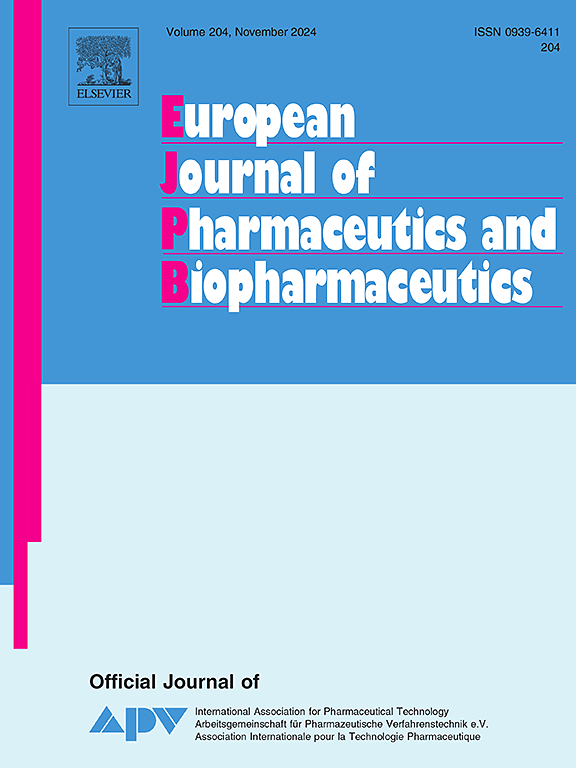Does needle clogging change the spatial distribution of injected drug in tissue? New insights by X-ray computed tomography
IF 4.4
2区 医学
Q1 PHARMACOLOGY & PHARMACY
European Journal of Pharmaceutics and Biopharmaceutics
Pub Date : 2025-02-01
DOI:10.1016/j.ejpb.2024.114615
引用次数: 0
Abstract
Prefilled syringes (PFS) are primary packaging materials that offer convenience and safety for subcutaneous injection of parenteral drug solutions. However, an increasingly common problem with the trend towards higher drug concentrations is the clogging of the needle during storage due to evaporative water loss and consequent solidification of the drug. In contrast to all previous studies on this topic, this work focuses on pharmacokinetically relevant aspects and investigates the effects of needle clogging on the spatial distribution of the injected drug in the tissue. X-ray computed tomography (XCT) (both tube-based and synchrotron-based) was used to visualize and analyze the spreading pattern and the fate of the injected liquid in porcine skin. By using controlled injection and force measurement the tissue distribution was correlated with the plunger force profile and the fluid dynamics of the jet. Studies of monoclonal antibody solution demonstrate that clogs, which are formed by evaporation of water and solidification of drug solution in the needle tip, usually dissolve in the flow of the liquid during injection. In the initial injection phase, the liquid jet starts to escape the needle only through a narrow channel in the clog. The resulting high dynamic pressure can alter the distribution of the liquid in the tissue, causing a long tail of liquid that penetrates deep into the fibrous network of the subcutaneous layer. However, the volume of this tail was calculated to be low relative to the overall volume of the injected drug solution (less than 2.4%) and is therefore unlikely to have a significant effect on the absorption kinetics of the injected drug. In addition, it was shown that if a clog were to enter the tissue, it would quickly dissolve.

针头堵塞是否会改变注射药物在组织中的空间分布?x射线计算机断层扫描的新见解。
预充注射器(PFS)是主要的包装材料,提供方便和安全的皮下注射非肠外药物溶液。然而,随着药物浓度越来越高的趋势,一个日益普遍的问题是,由于蒸发水分的损失和药物的凝固,在储存期间针头会堵塞。与以往关于该主题的所有研究相比,本研究侧重于药代动力学相关方面,并研究了针头堵塞对注射药物在组织中空间分布的影响。采用x射线计算机断层扫描(XCT)(管基和同步加速器)观察和分析注射液体在猪皮肤中的扩散模式和命运。通过控制注射和力测量,将组织分布与柱塞力分布和射流流体动力学相关联。对单克隆抗体溶液的研究表明,在注射过程中,水在针尖蒸发和药物溶液凝固形成的堵塞通常会溶解在液体的流动中。在初始注射阶段,液体射流仅通过堵塞中的狭窄通道从针头流出。由此产生的高动压可以改变液体在组织中的分布,导致液体的长尾深入到皮下层的纤维网络中。然而,根据计算,这条尾巴的体积相对于注射药物溶液的总体体积较小(小于2.4%),因此不太可能对注射药物的吸收动力学产生显著影响。此外,研究表明,如果阻塞物进入组织,它会迅速溶解。
本文章由计算机程序翻译,如有差异,请以英文原文为准。
求助全文
约1分钟内获得全文
求助全文
来源期刊
CiteScore
8.80
自引率
4.10%
发文量
211
审稿时长
36 days
期刊介绍:
The European Journal of Pharmaceutics and Biopharmaceutics provides a medium for the publication of novel, innovative and hypothesis-driven research from the areas of Pharmaceutics and Biopharmaceutics.
Topics covered include for example:
Design and development of drug delivery systems for pharmaceuticals and biopharmaceuticals (small molecules, proteins, nucleic acids)
Aspects of manufacturing process design
Biomedical aspects of drug product design
Strategies and formulations for controlled drug transport across biological barriers
Physicochemical aspects of drug product development
Novel excipients for drug product design
Drug delivery and controlled release systems for systemic and local applications
Nanomaterials for therapeutic and diagnostic purposes
Advanced therapy medicinal products
Medical devices supporting a distinct pharmacological effect.

 求助内容:
求助内容: 应助结果提醒方式:
应助结果提醒方式:


